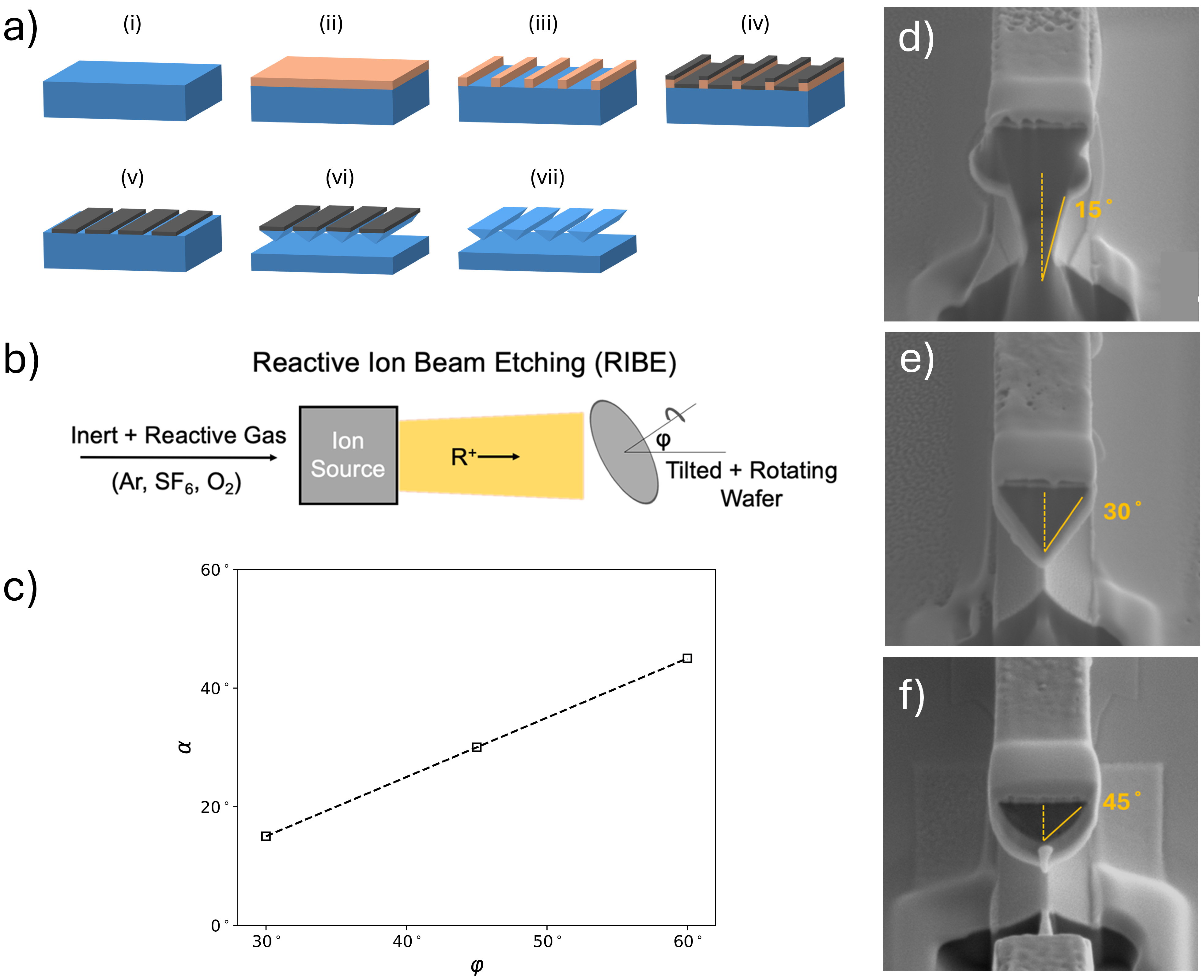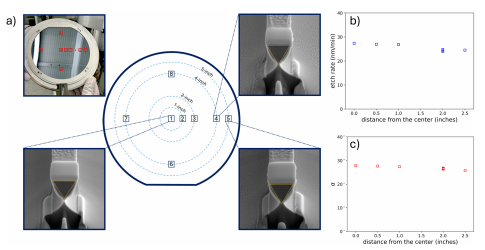Abstract
Color center platforms have been at the forefront of quantum nanophotonics for applications in quantum networking, computing, and sensing. However, large-scale deployment of this technology has been stifled by a lack of ability to integrate photonic devices at scale while maintaining the properties of quantum emitters. We address this challenge in silicon carbide which has both commercially available wafer-scale substrates and is a host to color centers with desirable optical and spin properties. Using ion beam etching at an angle, we develop a 5-inch wafer process for the fabrication of triangular cross-section photonic devices in bulk 4H-SiC. The developed process has a variability in etch rate and etch angle of 5.4% and 2.9%, respectively. Furthermore, the integrated color centers maintain their optical properties after the etch, thus achieving the nanofabrication goal of wafer-scale nanofabrication in quantum-grade silicon carbide.
1 Introduction
Nanophotonics has gained prominence over the last few decades for applications in classical fields of communications, nonlinear optics, sensing and displays, as well as the quantum field of information processing (QIP). Solid-state emitters with optically addressable spin states have been the frontrunners for scalable QIP implementation due to their capability of creating entanglement between electron spin and photon, and subsequently, the emitted photon can be used to distribute entanglement over long distances. When such an emitter, with the ability to generate indistinguishable spin-entangled photons, is integrated into a nanophotonic structure, it can reach the efficiencies in emission and collection of photons, necessary to implement QIP protocols. Earlier efforts in this direction, using quantum dots and the nitrogen vacancy color center in diamond, that demonstrated groundbreaking effects of quantum nanophotonics, struggled to reach scalability due to either the lack of scalable nanofabrication of the lack of spectral uniformity among emitters. Silicon carbide (SiC) promises to bridge these gaps. SiC is a well astablished host of color centers that combine long spin coherence times, excellent brightness, room-temperature spin manipulation, ample nuclear spins, ultra-narrow inhomogeneous broadening, and emission wavelengths in the near-infrared and telecom bands. Most importantly, SiC is available as a wafer-scale substrate, and its nanofabrication processes are CMOS compatible, making it a suitable platform for large-scale quantum nanophotonic hardware.
2 Wafer-scale etching of 4H-SiC
Ion beam etching is a physical milling process in which inert gases such as Argon are ionized in an RF ion source, and these ions are extracted as a collimated beam through a series of grids and accelerated towards the substrate to etch the target substrate. Variations of this process, reactive ion beam etching (RIBE) and chemically assisted ion beam etching (CAIBE) have a chemical etch component and are particularly useful for selective etching or etching materials that are tolerant to milling. In RIBE, inert gases in the ion source are substituted by reactive gases (SF6 and O2 for SiC), and the reactive gas ion beam accelerated towards the target substrate generates the etch. On the other hand, in CAIBE, inert gases are used in the ion source and reactive gases are separately introduced into a gas ring close to the target substrate. The accelerating inert gas ion beam, upon striking the reactive gas molecules close to the target substrate produces reactive gas ions that generate the etch. While both of these variations generates desirable etch outcomes, RIBE offers superior etch mask selectivity and wafer-scale uniformity, whereas CAIBE requires low maintainance for the ion source.
The triangular cross-section photonic devices were nanofabricated using the process flow as shown in Figure 1a (details in Methods). We developed a RIBE process involving SF6 and O2 gas chemistry, while maintaining the SF6 to O2 flowrates at a ratio 4:1 (etch process parameters in Methods). The undercut in these photonic structures was achieved by tilting the substrate holder (Figure 1b), to direct the ions underneath the nickel hard mask layer and rotation of substrate holder was used to ensure uniform etch in all directions. The etch angle (α), defined as the half angle at the apex of the triangular cross-section, varies linearly with the tilt angle of the substrate holder (φ), as shown in Figure 1c. The realized etch angle of the fabricated devices deviates from the expected etch angle, determined by the tilt angle, by 15◦ due to secondary fabrication processes. Figure 1d-f shows the SEM images of the cross-section of a 1 µm waveguides etched at tilt angles 30◦ , 45◦ , and 60◦ respectively. The devices etched at a tilt angle of 60◦ (Figure 1f) is the highest etch angle (45◦ ) reported for triangular cross-section devices fabricated in 4H-SiC, with an undercut of > 1µm.

Fig1
At the center, on the circumferences of 1-, 2- and 5-inch wafers, and four samples on the circumferences of a 4-inch wafer, as shown in Figure 2a. All the eight samples were etched simultaneously using the RIBE process developed at a tilt angle of 45◦ for a total of 70 minutes. The SEM images of the cross-section profiles of a 1 µm waveguide on samples placed at the center and on the circumferences of 4- and 5-inch wafers are shown in the insets of Figure 2a. We find that both the etch rate and etch angle decreases linearly along the radius of the wafer, as shown in Figure 2b-c. The etch rate and etch angle change linearly by 12.3% and 5%, respectively, from the center to the circumference of a 5-inch wafer. The variation in etch rate and etch angle among the four samples on the circumference of a 4-inch wafer was 1.2% and 0.6% respectively. This RIBE process has etch rate of (25.9 ± 1.4) nm/min, etch angle of (27 ± 0.8)◦ , and etch selectivity of > 8:1. To our knowledge, this is the first demonstration of a wafer-scale etch process for nanofabricating suspended photonic structures in bulk 4H-SiC.

Fig2
3 Discussion
The data in previous sections show results of what we believe is the first wafer-scale angle etch process using ion beam etching to fabricate triangular cross-section photonics in quantumgrade bulk 4H-SiC. Importantly, the etching process does not interfere with the optical properties of the photonic integrated color centers. This approach can be used to fabricate devices with a wide range of etch angles. Over a 5-inch wafer diameter, the variation in the etch rate and the etch angle is 5.4% and 2.9%, respectively, which can be countered by adjustments in the lithographic mask. In comparison, silicon carbide on insulator (SiCOI) approach quotes 1µm variation thickness across a 4-inch wafer, which could potentially triple the device thickness across the wafer if fabricated in a unified process. Previous modeling results have shown that variation in etch angles of triangular photonic crystal cavities shifts the resonant wavelength of the cavity without significantly affecting the quality factor and the mode volume. The change in etch angle from the center to 2.5 inch away from the center results in a 1.2% change in the resonant wavelength, and this can be compensated by including a variation of 1.6% in the lattice constant within the mask design to counter this resonant wavelength shift. For triangular waveguides, a variation of 2.9% in the etch angle does not significantly change the coupling efficiencies of the color center emission or the single-mode nature of these waveguides. The variation in the etch rate does not play a significant role in the triangular device fabrication because it does not affect the shape of the device, but only the height of the undercut region.
4 Methods
Prior to the lithographic process, we generated nitrogen vacancy centers in 4H-SiC through commercial (CuttingEdge Ions, LLC) implantation using 14N+ ions at an energy of 65 keV and a dose of 1 × 1014 cm−2, resulting in a peak nitrogen concentration at a depth of ∼ 100 nm, as calculated by stopping and range of ions in matter (SRIM) simulations. This was followed by an annealing step in a 1-inch Lindberg Blue tube furnace at 1050 ℃in nitrogen atmosphere for 60 minutes, to activate the implants. The process flow used for nanofabrication of triangular photonic devices in bulk 4H-SiC is shown in Figure 1a. First the 4H-SiC samples were spin coated with a 350 nm electron beam resist PMMA layer, and photonic patterns were transferred into this layer using a 100 keV electron-beam lithography (ii-iii). Then e-beam evaporation was used to deposit a 5 nm titanium adhesion layer and a 120 nm nickel hard mask layer, and lift-off was used to transfer the photonic patterns to this metal layer (iv-v). Triangular cross-section photonic devices were etched in 4H-SiC using the Intlvac Nanoquest II ion beam etching tool and finally the metal layers were removed by wet etching the samples in Transene’s nickel and titanium etchants (v-vi).
下一篇: GaN和相关异质结的金属辅助化学蚀刻